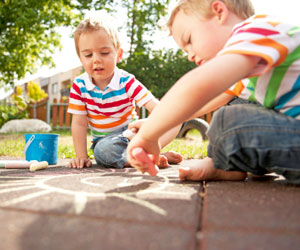Kids Come to Like Their Own Before They Dislike “Outsiders”
 Social groups form along all sorts of lines — from nationality to age to shared interests, and everything in between. We come to identify with our groups, whichever those might be, to the point where we prefer people who belong to our groups and discriminate against those who don’t.
Social groups form along all sorts of lines — from nationality to age to shared interests, and everything in between. We come to identify with our groups, whichever those might be, to the point where we prefer people who belong to our groups and discriminate against those who don’t.
These group affiliations undoubtedly confer tangible and intangible benefits, but those benefits often come at a cost to members of other so-called out-groups.
Given the consequences for human societies, researchers David Buttelman and Robert Bohm of the University of Erfurt in Germany set out to investigate the early origins of intergroup discrimination.
“Investigating the developmental origins of in-group love and out-group hate is important not only from a theoretical point of view but also from a practical perspective,” the researchers note. “For instance, to develop effective programs that may reduce prejudice and discrimination in childhood, it is important to know the underlying cognitions and motivations that lead to these phenomena in the first place.”
Given the relative prominence of in-group interactions early in life, they hypothesized that in-group love would be stronger in intensity and would develop earlier than out-group hate.
The researchers randomly assigned 45 6-year-olds and 36 8-year-olds to the “green” group or the “yellow” group. The groups included a hand puppet wearing that particular color, and they convened in opposite corners of the room.
The children were tasked with allocating various positive resources (e.g., a balloon, a cookie, a teddy bear) and negative resources (e.g., pieces of broken glass, moldy toast, a spider). Each resource could be given to the in-group puppet, the out-group puppet, or could be placed in a neutral box.
As expected, both 6 year-olds and 8 year-olds showed favoritism toward their own group, allocating the majority of the positive resources to the in-group puppet relative to the out-group puppet and the box.
But when it came to the negative resources, the 8 year-olds allocated a significantly greater percentage of the negative resources to the out-group than to the in-group or the neutral box.
“Whereas the younger children only prevented their in-group from receiving negative items, the older children intentionally harmed the out-group by giving the majority of negative items to the out-group rather than putting them in the neutral box (i.e., an egalitarian allocation),” Buttelmann and Bohm note.
The findings support the researchers’ hypothesis that in-group love and out-group hate are independent motivations, and that in-group love emerges earlier in development. They further indicate that out-group hate may be somewhat stronger for boys in the older group.
The researchers believe the overall findings have “far-reaching” implications:
“The increase of cooperation and solidarity within groups clearly is of utmost importance for human societies,” they note. “Children, and in particular boys, should be taught as early as preschool age that intragroup cooperation and loyalty are valuable and beneficial for humanity, and even their own group in the long run, only if they do not imply out-group derogation at the same time.”
![]()
Buttelmann, D., & Bohm, R. (2014). The ontogeny of the motivation that underlies in-group bias. Psychological Science. DOI: 10.1177/0956797613516802





APS regularly opens certain online articles for discussion on our website. Effective February 2021, you must be a logged-in APS member to post comments. By posting a comment, you agree to our Community Guidelines and the display of your profile information, including your name and affiliation. Any opinions, findings, conclusions, or recommendations present in article comments are those of the writers and do not necessarily reflect the views of APS or the article’s author. For more information, please see our Community Guidelines.
Please login with your APS account to comment.